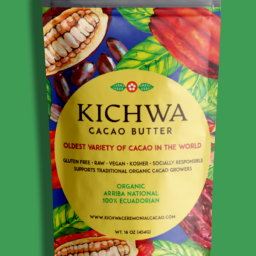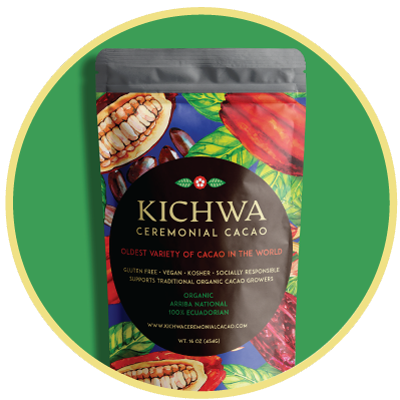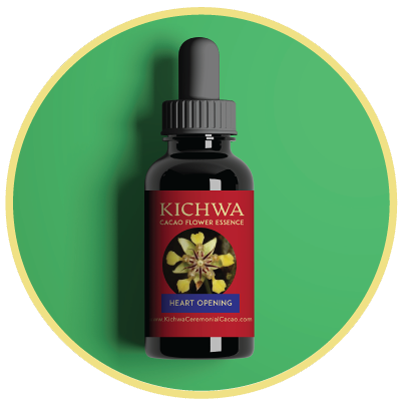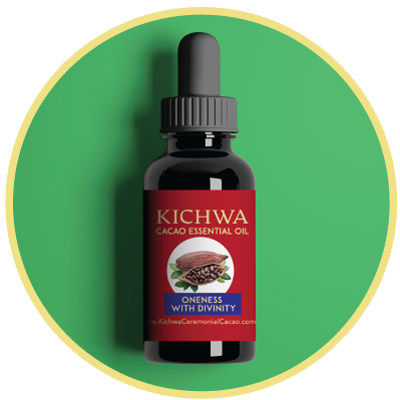Organic Raw Cacao Butter
Raw cacao butter is superior to cocoa butter because it hasn’t been treated with high heat, which destroys vital nutrients. Raw cacao butter is rich in antioxidants, polyphenols and essential fatty acids, which could have a positive effect on immune function, have anti-inflammatory effects, and support heart health.
Cacao butter is the edible, natural fat that makes up roughly half the content of dried cocoa beans. White or yellowish in color, it has a wonderful rich flavor and is one of the key ingredients in the production of chocolate.
Cacao Butter has a low melting point, somewhere between 32 and 35°C (89.6 and 95°F), which accounts for its characteristically soft and creamy texture—an attribute that makes cacao butter appealing for use in food and cosmetic products alike.
Typically, 100g of beans produces 40g of fat. Due to the extremely stable nature of cacao butter, it is easy to store with little danger of rancidity. Picking of the fruit occurs year-round and is still done by hand today.
The pods are sliced down from the trees with machetes and are cracked open to allow the removal of the cacao seeds. These are then placed in fermentation boxes for three to four days—a process that is essential for the chemical composition of the beans and the development of their renowned chocolate flavor. The seeds are then sun-dried on large trays or on the ground, losing much of their moisture and deepening to a reddish-brown color. At this stage the beans are called raw cacao.
Ecuadorian cacao butter is a delicious and healthier way to enjoy chocolate’s great taste without any unwanted sugars or additives. Largely made up of cholesterol-neutral fatty acids, it’s perfect eaten on its own; for your skin, it can be mixed with our cacao essential oil.
Try applying some onto your skin as a luxurious and nourishing moisturizer. Cacao butter has been widely used to reduce or prevent stretch marks. There is no substantial clinical evidence that it really works but the butter provides deep hydration to keep our skin supple and moist, which in turn can prevent or reduce the appearance of stretch marks. It has been noted to help with sensitive skin problems such as irritation, eczema and dermatitis.
A single cacao bean contains 54 percent fat (that’s the cacao butter), 31 percent carbohydrates (mainly fiber with a tiny amount of sugar), 11 percent protein (including arginine, glutamine and leucine), 3 percent polyphenols (flavonols and proanthocyanidins) and less than 1 percent trace minerals including magnesium, iron, copper and phosphorus.
Historically, cocoa performed a number of medical roles, treating conditions from smallpox and yellow fever to cholera and snakebites. Today we know flavonols found in our cacao can increase nitric oxide bioavailability, activate nitric oxide synthase, and exert anti-inflammatory and anti-platelet activity—all of which can improve vascular function and reduce blood pressure. Cacao has been studied for its ability to reduce blood pressure and has been shown to produce “a small but statistically significant effect in lowering blood pressure by 2–3mm Hg in the short term.” (Schardt, 2013)
Uplifting, Joyful Energy!
Eating cacao makes you happy! It contains phenylethylamine which controls pleasure and the feelings you get when you are in love. It also acts as a stimulant and can improve mental alertness. Cacao also contains serotonin and dopamine—which also stimulate good moods and “pleasure” feelings.
Anandamide (the “Bliss Molecule”) is also found in cacao. It is present in the brain as an endogenous substance and interacts with cannabinoid receptors. Cacao also contains great levels of magnesium, which is an essential mineral during times of stress, and helps you to feel more relaxed. It also contains manganese, zinc, calcium, and potassium.
Morning Ritual
By now, it’s pretty much standard practice to put a big ol’ scoop of coconut butter in our morning potions. Call it a plant-based version of the equally-loved Bulletproof-style coffee, which typically features some combination of grass-fed ghee, coconut oil, butter and/or MCT oil. Adding a dose of healthy fat to your morning coffee, matcha or smoothie is a great way to give your brain a boost first thing in the morning—and keep it going until lunch. But what about raw cacao butter? More recently marketed as a superfood, raw cacao butter is a healthy fat we should be keeping on our radar. Typically used in baking or in beauty DIYs, raw cacao butter is finally getting some recognition as the powerful food it really is.
What are the benefits?
Is there a difference between raw cacao butter and cocoa butter? Surprisingly, yes—a rather large one. Raw cacao butter is superior to cocoa butter because it hasn’t been treated with high heat, which destroys vital nutrients, so it remains a plant. Raw cacao butter is rich in antioxidants, polyphenols and essential fatty acids, which could have a positive effect on immune function, have anti-inflammatory effects, and support heart health.
How do I use raw cacao butter?
While you may first think of putting cacao butter on your skin, like cocoa butter, in fact it’s a super nourishing addition to recipes—it’s what gives high-quality chocolate its luxurious texture. Cacao butter can be used in a variety of recipes, including raw desserts and baked goods, and can be mixed with cacao powder in homemade chocolate recipes. Additionally, cacao butter can be added to hot drinks in place of coconut oil or coconut butter to add a creamy texture and a good dose of healthy fats. Of course, it’s also a gorgeous addition to DIY beauty recipes as well. Try using it in place of cocoa butter in at-home recipes for body butter and moisturizing bars.
Synopsis: The Raw Cacao bean is one of nature's most fantastic superfoods due to its mineral content and wide array of unique properties. Since many of the special properties of cacao are destroyed by cooking, refining and processing, planet Earth' s favorite food is still unknown to most of us. Now we get to reconnect with the power of real chocolate.
Chemical Constituents in RAW CACAO include (in alphabetic order):
3-ALPHA-L-ARABINOSIDYL-CYANIDIN
3-BETA-D-GALACTOSIDYL-CYANIDIN
4-HYDROXY-3-METHOXY-BENZOIC-ACID
3-METHYLOXYTYRAMINE
ACETIC-ACID 1,520 - 7,100 ppm
ALANINE 10,400 ppm
ALKALOIDS 33,900 ppm
ALPHA-THEOSTEROL
AMYL-ACETATE
AMYL-ALCOHOL
AMYL-BUTYRATE
AMYLASE
ANANDAMIDE
ARABINOSE
ARGININE 800+ ppm
ASCORBIC-ACID 31 ppm
ASCORBIC-ACID-OXIDASE
ASPARIGINASE
BETA-THEOSTEROL
CAFFEIC-ACID
CAFFEINE Petiole 51 - 525 ppm or 500 - 12,900 ppm, Skin 130-723 ppm
CALCIUM 800 - 1,100 ppm
CAMPOSTEROL
CARBOHYDRATES 347,000 - 445,000 ppm
CATALASE
CATECHINS 30,000 - 35,000 ppm
CHLORIDE 120 ppm
CHROMIUM (10 times more than whole wheat, highest of any major food)
CITRIC-ACID 4,500-7,500 ppm
COPPER 24 ppm
COUMARIN
CYANIDIN-3-BETA-L-ARABINOSIDE
CYANIDIN-3-GALACTOSIDE
CYANIDIN-GLYCOSIDE 4,000 - 5,000 ppm
DOPAMINE
EPIGALLOCATECHIN
ERGOSTEROL
ESCULETIN
FAT 371,000 - 582,300 ppm
FERULIC-ACID
FIBER 59,000 - 89,000 ppm
FORMIC-ACID
FURFUROL
GLUCOSE 3,000 ppm
GLUTAMIC-ACID 10,200 ppm
GLYCINE 900 ppm
HISTAMINE
HISTIDINE 800 ppm
INVERTASE
IRON 36 - 37 ppm
IRON-OXIDE 40 ppm
ISOBUTYL-ACETATE
ISOLEUCINE 5,600 ppm
L-EPICATECHIN 27,000 ppm
LACTIC-ACID
LEUCINE
LEUCOCYANIDINS 14,000 - 35,000 ppm
LINALOL 5 ppm
LINOLEIC-ACID
LINOLENIC-ACID
LIPASE
LYSINE 800 ppm
LYSOPHOSPHATIDYLCHOLINE
MAGNESIUM
MANNAN
MANNINOTRIOSE
MANNOSE
MELIBIOSE
MESO-INOSITOL
METHYLTETRAHYDROISOQUINOLINE
METHYL-HEPTENONE
N-BUTYLACETATE
N-LINOLEOYLETHANOLAMINE -- Anandamide reuptake inhibitor
N-NONACOSANE
N-OLEOLETHANOLAMINE -- Anandamide reuptake inhibitor
NIACIN 17 - 18 ppm
NICOTINAMIDE 21 ppm
NITROGEN 22,800 ppm
NONANOIC-ACID
O-HYDROXYPHENYLACETIC-ACID
OCTOIC-ACID
OLEIC-ACID 190,000 - 217,000 ppm
OLEO-DIPALMATIN 76,500 - 92,800 ppm
OLEOPALMITOSTEARIN
OXALIC-ACID 1,520 - 5,000 ppm
P-ANISIC-ACID
P-COUMARIC-ACID
P-HYDROXY-BENZOIC-ACID
P-HYDROXYPHENYLACETIC-ACID
P-TYRAMINE
PALMITIC-ACID
PALMITODIOLEN
PANTOTHENIC-ACID (Vitamin B-5) 13ppm
PECTIN
PENTOSE
PEROXIDASE
PHENYLACETIC-ACID
PHENYLALANINE 5,600 ppm
PHENYLETHYLAMINE
PHOSPHATIDYL-CHOLINE 92 - 1,328 ppm
PHOSPHOLIPIDS
PHOSPHORUS 3,600 - 5,571 ppm
POLYPHENOLS 78,000 - 100,000 ppm
PROLINE 7,200 ppm
PROPIONIC-ACID
PROTEIN 120,000 - 180,000 ppm
PROTEINASE
PROTOCATECHUIC-ACID
PURINE 30,000 - 40,000 ppm
PYRIDOXINE (Vitamin B6) 1 ppm
RIBOFLAVIN (Vitamin B2) 1 - 4 ppm
SALSOLINOL
SERINE 8,800 ppm
SEROTONIN
SITOSTEROL
SPERMIDINE
SPERMINE
STACHYOSE
STARCH 60,000 ppm
STEARIC-ACID
TANNINS 75,400 ppm
TARTARIC-ACID
TELEMETHYLHISTAMINE
THEOBROMINE 10,000 - 33,500 ppm
THEOPHYLLINE 3,254 - 4,739 ppm -- Theophylline is a methylxanthine with
diuretic and bronchial smooth muscle relaxant properties.
THIAMINE (Vitamin B1) 1 - 3 ppm
THREONINE 1,400 ppm
TOCOPHEROL (BETA, GAMMA) (Vitamin E forms)
TRIGONELLINE
TRYPTOPHAN
TYRAMINE
TYROSINE 5,700 ppm
VALERIANIC-ACID
VALERIC-ACID
VALINE 5,700 ppm
VANILLIC-ACID
VERBASCOSE
VERBASCOTETROSE
WATER 36,000 ppm
XYLOSE
We think of our Cacao as a plant medicine. As with any potent medicine, it is important to be mindful in its use.
In most cases, there are no concerns to be aware of. The points listed below are mainly a concern when you take higher doses, as is done when the Cacao is used ceremonially. In these cases, the combination of potent cacao and a higher dose warrants some additional mindfulness.
First, if you are working with it ceremonially, we recommend that you start off with about half the full dose. A full dose, the maximum we use, is two ounces, so that means starting off with one ounce. See how it feels and wait at least thirty minutes before consuming more.
Cacao is a strong bitter and stimulant, so there are some potential side effects to be aware of, as well as certain contra-indications. Since cacao is consumed in higher doses in ceremony, people might experience symptoms such as light-headedness, sweaty palms, headache, or nausea. Simply slow down, drink water, and practice self-care as needed until symptoms subside. Cacao can also stimulate detox symptoms in some cases. If this happens, take it as a blessing and drink plenty of water as your body lets go of whatever it didn’t like. This will likely be accentuated for people on a raw diet or who are fasting. Go with lower doses in this case.
Certain antidepressants are worth extra consideration. MAOI-based antidepressants are contraindicated with the tyramine in chocolate, so a larger dose of cacao is not recommended. MAOI-based antidepressants are first-generation antidepressants and are less common these days. People taking them are on a restricted diet that includes limiting or avoiding chocolate, so they should know if they can consume or not. Side effects could include more serious headache and nausea, so make sure to check medications first.
Additionally, there has been some concern with larger doses of cacao and SSRI type antidepressants because of the MAOIs in cacao. Specifically, tryptophan, a type of MAOI that is a precursor to serotonin, has been cited by some as a possible contraindication. The research about this interaction is minimal, but studies on both the amounts of tryptophan in chocolate and how that might cause “serotonin syndrome” don't indicate any problem. However, to be on the safe side, for those on SSRIs, we suggest consulting with your doctor and/or pharmacist regarding higher doses of cacao and to consider starting with low doses.
If you have a serious heart condition: The theobromine in cacao increases heart rate significantly and is a vasodilator, lowering blood pressure. If you have such a condition, consider consulting a physician and certainly go lighter on amounts.
If you are pregnant or breastfeeding: The theobromine in cacao, which is very similar to caffeine, has a stimulating effect. Thus, we recommend using lower dosages (e.g., a maximum of one ounce in a ceremonial drink).
Pure cacao can be fatal to dogs (and possibly horses and parrots), so be sure to keep it away from pets.
If any symptoms do present, drink lots of water, get some rest, and the symptoms will pass.







